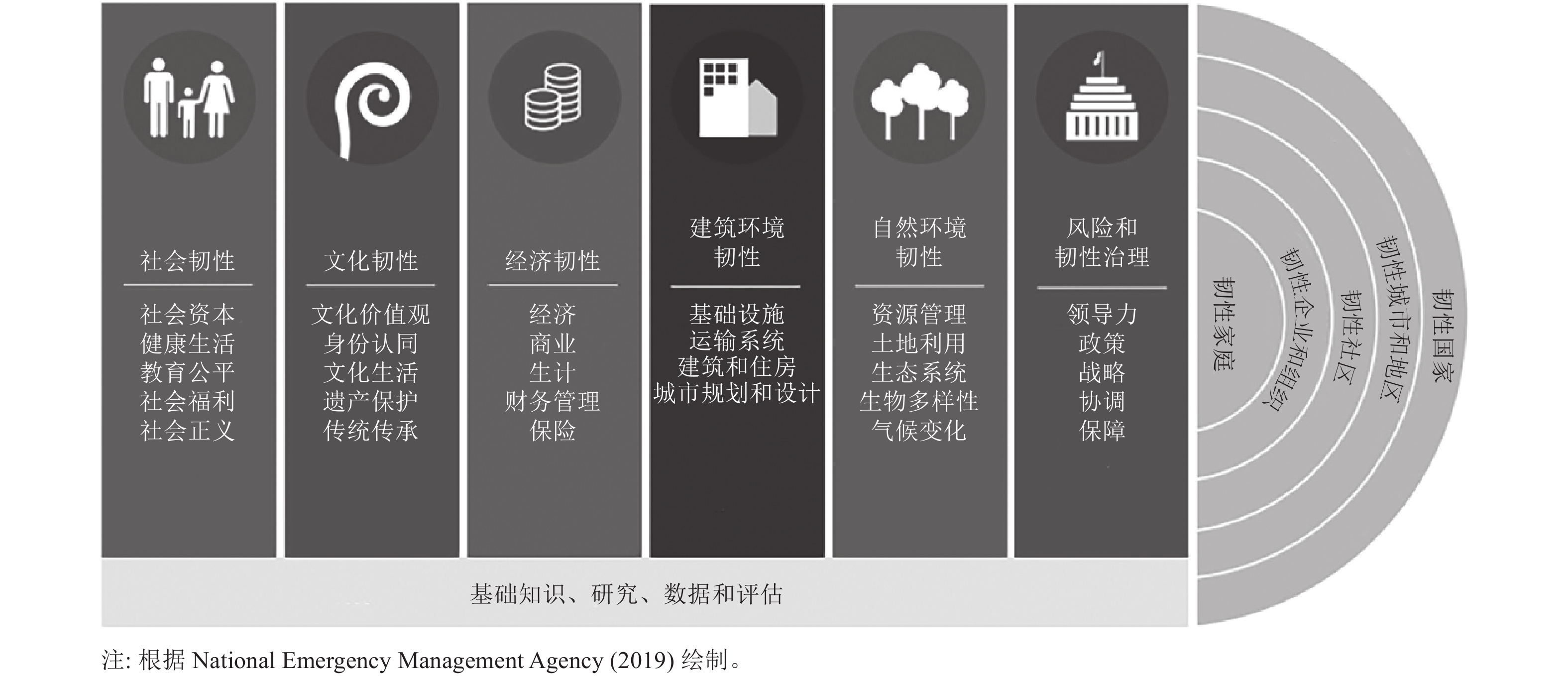Experience and Enlightenment of Earthquake Resilience Practice in New Zealand
-
摘要: 地震韧性指受灾系统在地震灾害中具有承受、恢复和学习转化的能力,为抗震减灾工作提供了新的理论指导和建设思路。作为一个地震频发的国家,新西兰的地震应对已有百年历史,地震韧性建设相对成熟,主要通过开展顶层设计、建立韧性组织体系、提升城市设施韧性、强化社区抗震减灾能力和利用信息技术辅助灾害响应等举措,提升新西兰的地震韧性。我国抗震任务繁重,建设地震韧性城市具有必要性和挑战性,新西兰地震韧性建设经验可为我国提供有益借鉴。本文旨在总结新西兰地震韧性建设成功经验的基础上,为我国地震韧性理论发展和地震韧性城市建设提供参考和启发。Abstract: Seismic resilience, as a reflection of the concept of resilience in earthquake disaster response, offers new theoretical guidance and practical strategies for earthquake mitigation efforts. New Zealand, being an earthquake-prone country with a century-long history of earthquake response, has developed a relatively mature framework for constructing earthquake resilience. This enhancement has been achieved through top-level design, the establishment of resilient organizational systems, improvements to urban infrastructure resilience, the strengthening of community earthquake mitigation capacities, and the integration of information technology to assist disaster response. In contrast, China faces significant seismic challenges, making the construction of earthquake-resilient cities a daunting objective. The successful experiences of New Zealand in building earthquake resilience provide valuable references and lessons for developing earthquake resilience theories and constructing resilient cities in China. By analyzing New Zealand's approach, China can better navigate its seismic challenges and improve its strategies for earthquake mitigation and disaster response.
-
Key words:
- Resilience /
- Seismic resilience /
- New Zealand /
- Earthquake resilient cities /
- Community resilience
-
表 1 “4R”框架具体内容
Table 1. The content of “4R” framework
4R 具体内容 减少风险(Reduction) 评估、分析灾害和风险,在可行的情况下采取措施消除这些风险;如果没有,则将其影响程度和
发生的可能性降低至可接受的水平。准备工作(Readiness) 建立有效的风险管理运作体系,包括为公众制定自助和应对方案,为紧急服务、生命线公用事业和
其他机构制定计划。应对(Response) 在紧急情况发生之前、期间或之后立即采取行动,以挽救生命和财产,并帮助社区恢复。 恢复(Recovery) 制定紧急情况下社区的短期、中期和长期恢复计划。 注:表格根据National Emergency Management Agency(2002)绘制。 表 2 响应级别描述
Table 2. The concept of response level
响应级别 描述 国家 包括国家组织的协调中心和总部,以及国家级部门协调实体和集群。由国家协调中心(NCC)协调。 区域 包括地区民防应急管理(CDEM)小组、卫生委员会(DHBs)、区域间DHB协调、警区、消防和区域组织办事处。由应急协调中心(ECC)协调。 地区 包括地方当局、地区委员会和设在地方的组织办公室(区、市)。由应急行动中心(EOC)协调。 事件 第一级官方反应,包括第一反应人员。由事故控制点(ICP)协调。 社区 公众,包括个人、家庭、社区团体和参与响应的企业。这一层面通常不构成正式响应结构的一部分。 注:根据National Emergency Management Agency(2020)绘制。 -
方东平,李全旺,李楠等,2020. 社区地震安全韧性评估系统及应用示范. 工程力学,37(10):28−44. doi: 10.6052/j.issn.1000-4750.2019.11.0670Fang D. P., Li Q. W., Li N., et al., 2020. An evaluation system for community seismic resilience and its application in a typical community. Engineering Mechanics, 37(10): 28−44. (in Chinese) doi: 10.6052/j.issn.1000-4750.2019.11.0670 贾明明,袁昊祯,彭慧君,2022. 松原地区群体建筑结构地震响应及抗震韧性分析. 地震工程学报,44(3):509−517.Jia M. M., Yuan H. Z., Peng H. J., 2022. Earthquake response and seismic resilience of group building structures in the Songyuan area. China Earthquake Engineering Journal, 44(3): 509−517. (in Chinese) 景梦晗,2021. 城市社区抗震韧性评估模型优化研究. 成都:西南交通大学.Jing M. H., 2021. Study on optimization of seismic resilience evaluation model for urban communities. Chengdu: Southwest Jiaotong University. (in Chinese) 康现栋,付皓然,赵光等,2021. 单体建筑抗震韧性评估方法研究与应用. 土木工程学报,54(8):37−42.Kang X. D., Fu H. R., Zhao G., et al., 2021. Research and application of evaluation methods for earthquake resilience of individual building structure. China Civil Engineering Journal, 54(8): 37−42. (in Chinese) 李明浩,Liu A.,董文晨,2019. 新西兰木结构抗震研究进展. 建设科技,(17):25−30.Li M. H., Liu A., Dong W. C., 2019. Progress in seismic research of wood structures in New Zealand. Construction Science and Technology, (17): 25−30. (in Chinese) 刘渊,王自法,赵登科,2021. 基于新西兰详细地震破坏数据的建筑物构件损失分析. 地震工程与工程振动,41(5):186−195.Liu Y., Wang Z. F., Zhao D. K., 2021. Building component level loss analysis based on detailed earthquake loss data in New Zealand. Earthquake Engineering and Engineering Dynamics, 41(5): 186−195. (in Chinese) 刘子艺,郭小东,王志涛等,2021. 空间尺度下城市医疗系统震后应急救援能力评估与韧性提升策略. 地震工程与工程振动,41(5):196−205.Liu Z. Y., Guo X. D., Wang Z. T., et al., 2021. Assessment of emergency rescue capability and resilience improvement strategy of urban medical system after earthquake in spatial scale. Earthquake Engineering and Engineering Dynamics, 41(5): 196−205. (in Chinese) 尚庆学,2021. 医疗系统抗震韧性评价方法研究. 哈尔滨:中国地震局工程力学研究所.Shang Q. X., 2021. Research on seismic resilience assessment method of hospital systems. Harbin:Institute of Engineering Mechanics,China Earthquake Administration. (in Chinese) 杨敏行,黄波,崔翀等,2016. 基于韧性城市理论的灾害防治研究回顾与展望. 城市规划学刊,(1):48−55.Yang M. X., Huang B., Cui C., et al., 2016. Review and prospect: urban disaster resilience. Urban Planning Forum, (1): 48−55. (in Chinese) 翟长海,刘文,谢礼立,2018. 城市抗震韧性评估研究进展. 建筑结构学报,39(9):1−9.Zhai C. H., Liu W., Xie L. L., 2018. Progress of research on city seismic resilience evaluation. Journal of Building Structures, 39(9): 1−9. (in Chinese) Anelli A., Santa-Cruz S., Vona M., et al., 2019. A proactive and resilient seismic risk mitigation strategy for existing school buildings. Structure and Infrastructure Engineering, 15(2): 137−151. doi: 10.1080/15732479.2018.1527373 Bakema M. M., Parra C., McCann P., 2019. Learning from the rubble: the case of Christchurch, New Zealand, after the 2010 and 2011 earthquakes. Disasters, 43(2): 431−455. doi: 10.1111/disa.12322 Becker J. S., Potter S. H., McBride S. K., et al., 2020. Forecasting for a fractured land: a case study of the communication and use of aftershock forecasts from the 2016 MW7.8 Kaikōura Earthquake in Aotearoa New Zealand. Seismological Research Letters, 91(6): 3343−3357. doi: 10.1785/0220190354 Chowdhury M., Prayag G., Orchiston C., et al., 2019. Postdisaster social capital, adaptive resilience and business performance of tourism organizations in Christchurch, New Zealand. Journal of Travel Research, 58(7): 1209−1226. doi: 10.1177/0047287518794319 Christchurch N. Z., 1997. Risks & realities. Canterbury: Centre for Advanced Engineering, University of Canterbury. Christophersen A., Rhoades D. A., Gerstenberger M. C., et al., 2017. Progress and challenges in operational earthquake forecasting in New Zealand. In: Proceedings of 2017 NZSEE Conference. New Zealand: NZSEE . Cimellaro G. P., Reinhorn A. M., Bruneau M., 2010. Framework for analytical quantification of disaster resilience. Engineering Structures, 32(11): 3639−3649. doi: 10.1016/j.engstruct.2010.08.008 Cimellaro G. P., Solari D., Bruneau M., 2014. Physical infrastructure interdependency and regional resilience index after the 2011 Tohoku Earthquake in Japan. Earthquake Engineering & Structural Dynamics, 43(12): 1763−1784. Cretney R. M., 2016. Local responses to disaster: the value of community led post disaster response action in a resilience framework. Disaster Prevention and Management, 25(1): 27−40. doi: 10.1108/DPM-02-2015-0043 Crowley K., Elliott J. R., 2012. Earthquake disasters and resilience in the global north: lessons from New Zealand and Japan. The Geographical Journal, 178(3): 208−215. doi: 10.1111/j.1475-4959.2011.00453.x Cubrinovski M., Bradley B. A., Elwood K. J., et al., 2020. Wellington’s earthquake resilience: lessons from the 2016 Kaikōura Earthquake. Earthquake Spectra, 36(3): 1448−1484. doi: 10.1177/8755293020919426 Darani F. M., Zarnani P., Quenneville P., 2022. Development of a new self-centring structural connector for seismic protection of structures. Journal of Constructional Steel Research, 189: 107064. doi: 10.1016/j.jcsr.2021.107064 Elkhidir E., Mannakkara S., Henning T. F. P., et al., 2022. Knowledge types and knowledge transfer mechanisms for effective resilience knowledge-sharing between cities–A case study of New Zealand. International Journal of Disaster Risk Reduction, 70: 102790. doi: 10.1016/j.ijdrr.2022.102790 EQC, 2021. How Kaikoura earthquake changed insurance response. (2021-11-12)[2022-07-28]. https://www.eqc.govt.nz/news/how-kaikoura-earthquake-changed-insurance-response/. EQC, GNS Science, 2016. Earthquake Statistics. (2024)[2024-08-17]. https://www.geonet.org.nz/earthquake/statistics_long Filippova O., Xiao Y., Rehm M., et al., 2018. Economic effects of regulating the seismic strengthening of older buildings. Building Research & Information, 46(7): 711−724. Horsfall S., Hatton T., Collins T., et al., 2022. Is health and safety legislation an effective tool for disaster risk reduction? A case study from New Zealand. International Journal of Disaster Risk Reduction, 70: 102773. doi: 10.1016/j.ijdrr.2021.102773 Jacques C. C., Mcintosh J., Giovinazzi S., et al., 2014. Resilience of the canterbury hospital system to the 2011 Christchurch earthquake. Earthquake Spectra, 30(1): 533−554. doi: 10.1193/032013EQS074M Jayasinghe K., Kenney C. M., Prasanna R., et al., 2020. Enacting "accountability in collaborative governance": lessons in emergency management and earthquake recovery from the 2010–2011 Canterbury Earthquakes. Journal of Public Budgeting, Accounting & Financial Management, 32 (3): 439−459. Le Dé L., Wairama K., Sath M., et al., 2021. Measuring resilience: by whom and for whom? A case study of people-centred resilience indicators in New Zealand. Disaster Prevention and Management: An International Journal, 30(4-5): 538−552. Ministry of Business, 2022a. Innovation and employment. seismic-risk-guidance-for-buildings. (2022-07-04)[2023-02-02]. https://www.building.govt.nz/assets/Uploads/getting-started/seismic-risk-guidance-for-buildings.pdf. Ministry of Business, 2022b. National seismic hazard model. (2022-10-04)[2023-02-02]. https://www.building.govt.nz/getting-started/seismic-work-programme/national-seismic-hazard-model/ National Emergency Management Agency, 2002. The 4 Rs. (2020-11-09)[2022-07-28]. https://www.civildefence.govt.nz/cdem-sector/the-4rs/ National Emergency Management Agency, 2019. National disaster resilience strategy. (2020-11-09)[2024-08-17]. https://www.civildefence.govt.nz/cdem-sector/plans-and-strategies/national-disaster-resilience-strategy. National Emergency Management Agency, 2020. Coordinated incident management system (CIMS) third edition. (2024-05-27)[2024-06-01]. https://www.civildefence.govt.nz/resources/coordinated-incident-management-system-cims-third-edition. Natural Hazards Commission, 2019. New Zealand to have world-leading natural hazard risk modelling tool. (2019-08-01)[2024-08-17]. https://www.naturalhazards.govt.nz/news/new-zealand-to-have-world-leading-natural-hazard-risk-modelling-tool/ NYC Government, 2013. 2013 Plan: a stronger, more resilient New York. (2013-06-01)[2022-07-28]. https://a860-gpp.nyc.gov/concern/nyc_government_publications/37720d67f. Riga E., Karatzetzou A., Fotopoulou S., et al., 2020. Urban seismic risk model for resilient cities. The case of Thessaloniki. IOP Conference Series: Earth and Environmental Science, 410(1): 012107. doi: 10.1088/1755-1315/410/1/012107 Seebeck H., Van Dissen R., Litchfield N., et al., 2024. The New Zealand community fault model–version 1.0: an improved geological foundation for seismic hazard modelling. New Zealand Journal of Geology and Geophysics, 67(2): 209−229. doi: 10.1080/00288306.2023.2181362 Seville E., Metcalfe J., 2005. Developing a hazard risk assessment framework for the New Zealand state highway network. Wellington: Land Transport New Zealand. SPUR, 2009. Defining resilience: what San Francisco needs from its seismic mitigation policies. (2009-02-01)[2022-07-28]. https://www.spur.org/publications/spur-report/2009-02-01/defining-resilience. Sye E., Calder N., 2012. Community resilience within the Lyttelton harbour basin. (2024-01-24)[2024-8-17] https://www.canterbury.ac.nz/content/dam/uoc-main-site/documents/pdfs/d-other/geography-repository/GEOG309_2012_Harbour_Basin_Resilience_Report.pdf. The Resilient Cities Network, 2019. Resilient cities, resilient lives: learning from the 100RC network. (2020-08-21)[2022-07-28]. https://resilientcitiesnetwork.org/downloadable_resources/UR/Resilient-Cities-Resilient-Lives-Learning-from-the-100RC-Network.pdf. The University of Edinburgh, 2021. Operational earthquake forecasting. (2021-11-05)[2023-02-02]. https://www.ed.ac.uk/geosciences/research/impact/earth/earthquake. Thornley L., Ball J., Signal L., et al., 2015. Building community resilience: learning from the Canterbury Earthquakes. Kōtuitui: New Zealand Journal of Social Sciences Online, 10(1): 23−35. doi: 10.1080/1177083X.2014.934846 Vannier C., Mulligan H., Wilkinson A., et al., 2021. Strengthening community connection and personal well‐being through volunteering in New Zealand. Health and Social Care in the Community, 29(6): 1971−1979. doi: 10.1111/hsc.13340 -




 下载:
下载:



